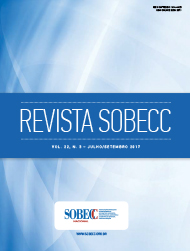Effectiveness of the protocol for the prevention of skin lesions in robotic urological surgeries
DOI:
https://doi.org/10.5327/Z1414-4425201700030006Keywords:
Enfermagem perioperatória. Úlcera por pressão. Robótica. Posicionamento do paciente.Abstract
Objectives: To verify the effectiveness of the Skin Lesion Prevention Protocol by analyzing the occurrence of lesions caused by surgical positioning
in cancer patients undergoing robotic urological surgeries; to demonstrate the importance of simulations as educational strategies for training
nursing teams. Method: This study includes a descriptive, retrospective, quantitative approach, and refers to the year of 2015. The study was performed
at the surgery center of a cancer hospital that performs on average 1,000 surgeries per month. Results: In 2015, 359 robotic urological procedures were
performed, of which 298 cases were prostatectomies. There were no skin lesions caused by positioning in the observed period. Conclusion: In this study,
the occurrence of skin lesions associated with the surgical positioning of cancer patients undergoing robotic urological surgeries was zero. This result
proves the effectiveness of the institutional protocol and demonstrates the importance of simulation as an educational improvement strategy to guarantee
the success of robotic surgical positioning.
References
Brasil. Instituto Nacional de Câncer José Alencar Gomes da Silva. Estimativa
: incidência de câncer no Brasil. Rio de Janeiro: INCA; 2015.
Ulmer BC. Best Practices for Minimally Invasive Procedures. AORN
J. 2010;91(5):558-72.
Camarillo DB, Krummel TM, Salisbury JK Jr. Robotic technology in
surgery: past, present, and future. Am J Surg. 2004;188:2S-15S.
Sant’anna RT, Prates PRL, Sant’Anna JRM, Prates PR, Kalil RAK, Santos
DE, et al. Emprego de sistemas robóticos na cirurgia cardiovascular.
Rev Bras Cir Cardiovasc. 2004;19(2):171-8.
Ramos JR, Davila EP. Cirurgia robótica para o tratamento do câncer do
reto distal: sistematização técnica. Rev Col Bras Cir. 2014;41(3):216-23.
Domene CE. Cirurgia robótica: um passo em direção ao futuro. Arq
Bras Cir Dig. 2014;27(4):233.
Carneiro GA, Leite RCBO. Lesões de pele no intra-operatório de
cirurgia cardíaca: incidência e caracterização. Rev Esc Enferm USP.
;45(3):611-6.
Spruce L. Back to Basics: Preventing Perioperative Pressure Injuries.
AORN J. 2017;105(1):92-9.
Silveira CT. A assistência da equipe de enfermagem no posicionamento
cirúrgico do paciente durante o período intraoperatório [dissertação].
São Paulo: Escola de Enfermagem da Universidade de São Paulo; 2008.
Barbosa MH, Oliva AMB, Sousa Neto AL. Ocorrência de lesões
perioperatórias por posicionamento cirúrgico. Rev Cubana Enferm.
Mar;27(1):31-41.
Scarlatti KC, Michel JLM, Gambá MA, Gutiérrez MGR. Úlcera por
pressão em pacientes submetidos à cirurgia: incidência e fatores
associados. Rev Esc Enferm USP. 2011;45(6):1372-9.
Lopes CMM, Haas VJ, Dantas RAS, Oliveira CG, Galvão CM. Assessment
scale of risk for surgical positioning injuries. Rev Latino-Am
Enfermagem. 2016;24:e2704.
Association of Perioperative Registered Nurses. Guidelines for Perioperative
Practice. Denver: Association of Perioperative Registered Nurses; 2017.
Vargas MAO. Simulação na formação e na qualificação do profissional
de enfermagem. Enferm Foco. 2014;5(1/2):1-2.
Nilsson UG. Intraoperative Positioning of Patients Under General
Anesthesia and the Risk of Postoperative Pain and Pressure Ulcers.
J Perianesth Nurses. 2013;28(3):137-43.
Sotelo RJ, Haese A, Machuca V, Medina L, Nuñez L, Santinelli F, et al.
Safer Surgery by Learning from Complications: A Focus on Robotic
Prostate Surgery. Eur Urol. 2016 Feb;69(2):334-44.
Gezginci E, Ozkaptan O, Yalcin S, Akin Y, Rassweiler J, Gozen AS.
Postoperative pain and neuromuscular complications associated
with patient positioning after robotic assisted laparoscopic radical
prostatectomy: a retrospective non‑placebo and non‑randomized
study. Int Urol Nephrol. 2015;47:1635-41.
Sutton S, Link T, Makic MBF. A Quality Improvement Project for Safe
and Effective Patient Positioning During Robot-Assisted Surgery.
AORN J. 2013;97(4):448-56.
Downloads
Published
How to Cite
Issue
Section
License
By publishing in Revista SOBECC, authors retain the copyright of their article and agree to license their work using a Creative Commons Attribution (CC BY 4.0) International Public License, thus accepting the terms of this license. The CC BY 4.0 license allows others to distribute, remix, adapt, and create from the published article, even for commercial purposes, provided they give due credit to the creators of the work (authors of the article).
The authors grant to Revista SOBECC the right of first publication, to identify itself as the original publisher, and grant to the journal a non-exclusive license to use the work in the following ways: (1) to sell and/or distribute the article in hard copies and/or in electronic format; (2) to distribute parts and/or the entire article in order to promote the journal through the internet and other digital and printed media; (3) to record and reproduce the article in any format, including digital media.
With this license, authors can enter into separate contracts for non-exclusive distribution of the article (e.g., publishing in an institutional repository or as a book chapter), with acknowledgement of authorship and initial publication in Revista SOBECC. Authors are encouraged to publish and distribute their work online after publication in the Revista SOBECC, as this can increase the article's visibility and impact.
In line with the journal's policies, each published article will be assigned a CC BY 4.0 license, which will be visible on the abstract page and in the PDF of each article with the respective link to the license terms.











